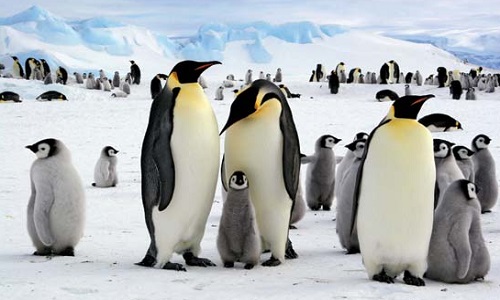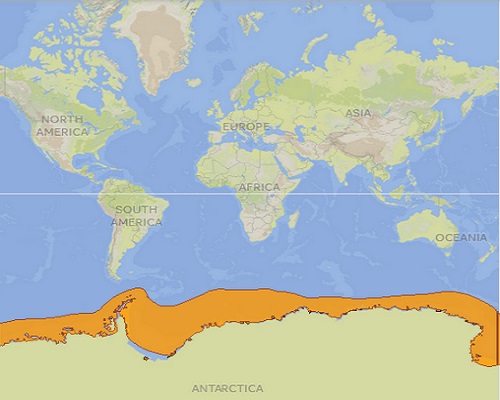Taxonomy

Emperor penguin colony in Antarctica. The IUCN Red List of Threatened Species lists this species as “Near Threatened”
- Kingdom: Animalia
- Phylum: Chordata
- Class: Aves
- Order: Sphenisciformes
- Family: Spheniscidae
- Genus: Aptenodytes
- Species: Aptenodytes forsteri
Name
- Common name: Emperor penguin.
- Scientific name: Aptenodytes forsteri
o
o
Distribution and Habitat
- Emperor penguins live in the waters of the Antarctic, the continental shelf, fast ice and surrounding islands.
- Its distribution is limited to the area between 66˚ and 78˚ South latitude.
- They have a circumpolar range.
- They breed in colonies found on pack ice up to 75 miles or 120 km off shore near ice cliffs and icebergs that shelter them from the wind.
- Their habitat may reach temperatures below 40˚C or 40˚F and winds of up to 89 mph or 144 km/h. Water temperature is 28.8˚F or -1.8˚C.
Physical Features
- Emperor penguins are the largest species of penguin and the largest flightless water bird.
- They have dark gray feathers on the dorsal side and black wings, feet, chin, head and throat. The black feathers are sharply delineated from the cream or white chest and belly.
- They use their wings as paddles for swimming as they cannot fly.
- They have a yellow band near its ears and on the sides of the head that fades toward the neck and chest.
- Their bodies are covered by four layers of feathers and body fat that keep them insulated.
- Its dark plumage fades to brown in the summer before they moult in January and February. Moulting takes an average of 34 days.
- The emperor penguin is able to thermoregulate their bodies between a range of -10 to 20˚C or 14 to 68˚F without altering its metabolism.
Height and Weight
- Males and females are similar in size and weight.
- Emperor penguins can weigh up to 99 lbs or 45 kg.
- They can be up to 51 in or 1.30 m tall.
Behavior
- Emperor penguins are social animals that forage and nest in groups.
- From January to March they live in the ocean. In March and April when the winter begins adult penguins travel to breeding grounds.
- Emperor penguins hunt during the day with the aid of sunlight.
- They can swim an average of up to 9 mph or 14.5 k/h.
- The male incubates the egg while the female returns to sea to eat and bring food to the male and the newborn chick. During this time the male does not eat.
- These penguins endure the harshest weather conditions and protect themselves by huddling together and continually rotating from the outer edge to the inner circle.
- Emperor penguins do not maintain a home range.
- They can remain submerged for up to 18 minutes.
- In order to reach breeding colonies they have to travel up to 75 miles or 120 km.
- They use a complex set of vocal calls to identify their mates and offspring.
Diet
- Emperor penguins are carnivorous and feed mostly fish, krill and squid.
- They eat an average of 20% of their body weight.
Reproduction
- Both male and female reach reproductive maturity at 5 years old.
- Emperor penguins have an annual breeding cycle.
- In March emperor penguins walk up to 75 miles or 120 km to reach breeding grounds where they will find a mate.
- Both male and female stay monogamous for one breeding season.
- The female lays one egg between May and June, soon after she leaves to find food. The egg is incubated by the male who must keep it in its pouch for more than 2 months until the female returns. Average hatching time is 64 days.During this time the male does not eat.
- Male and female loose from 30 to 50% of their weight.
- To keep warm in temperatures of -40°F or -40ºC thousands of male penguins huddle together until their eggs hatch.
- The female returns in August and locates the male and her chick by making a specific vocalization. Then it is the male’s turn to return to sea and look for food.
- Chicks stay with their parents for 150 days and then head to the sea.
Predators
- Killer whales, leopard seals, gulls, skuas, giant petrels.
Threats
- Global warming is a major factor affecting penguins. Some areas in the Antarctic are experiencing increase in temperatures causing the ice to melt and reducing the amount of krill, their major source of food.
Life Expectancy
- In the wild the emperor penguin lives an average of 20 years.
- Only 20% of newborns survive their first year.
Conservation Status
- The IUCN Red List of Threatened Species lists the emperor penguin as a near threatened species. It predicts a decline in population due to climate change.
- The species is subject to on-going international research. Human contact is highly regulated.
References and further research
University of Wisconsin-La Crosse Bioweb – Emperor Penguin Aptenodytes forsteri
IUCN Red List of Threatened Species – Aptenodytes forsteri (Emperor Penguin)
University of Michigan Museum of Zoology – Aptenodytes forsteri emperor penguin
Marine Biology Conservation Society – Emperor penguins
Australian Government Department of the Environment – Australian Antarctic Division
BBC Nature Wildlife – Emperor penguin
Center for Biological Diversity – Natural History Emperor Penguin
ITIS Report Aptenodytes forsteri
Google Scholar Emperor Penguin

